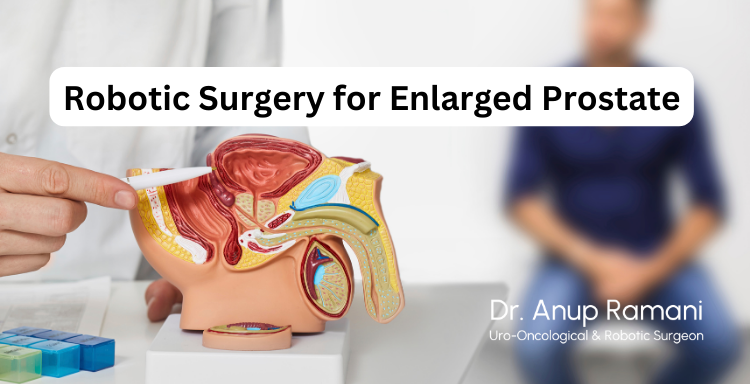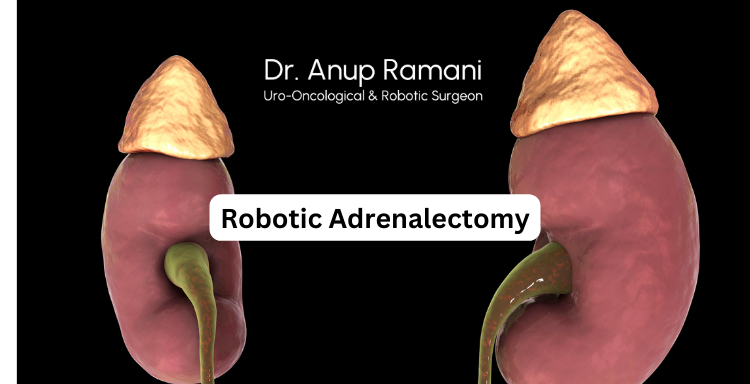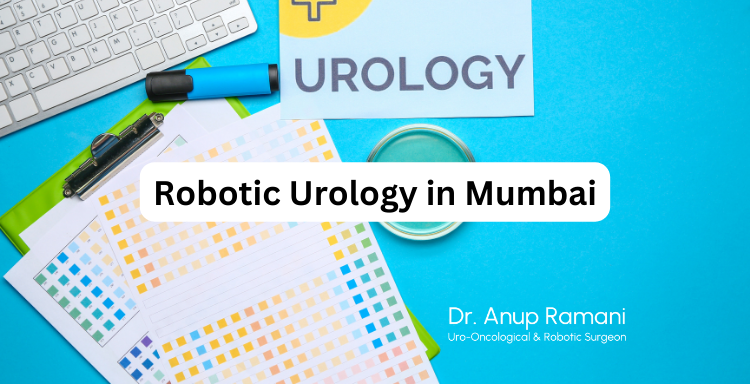Dr Anup Ramani @ Copyright 2024
By Dr. Anup Ramani
Mumbai has rapidly emerged as a global leader in robotic urology, attracting patients from around the world. With cutting-edge technology, world-class surgeons, and a thriving medical tourism industry, the city has positioned itself at the forefront of urological advancements. Robotic surgery, particularly in urology, has seen significant growth here, offering improved precision, faster recovery times, and enhanced outcomes for patients suffering from conditions like prostate cancer, bladder cancer, and kidney disorders.
Mumbai as a Global Hub for Robotic Urology
Mumbai’s journey to becoming a global leader in robotic urology is a testament to the city’s adaptability and commitment to healthcare innovation. Known for its renowned medical institutions and expert professionals, the city has invested heavily in adopting robotic technologies to treat complex urological conditions. International patients flock to Mumbai not just for the advanced treatments but also for the expertise of highly qualified urologists in Mumbai, who are at the forefront of these innovations.
The Role of Technology in Robotic Urology
Robotic surgery is revolutionizing the field of urology by enabling Minimal invasive procedures that offer greater precision. Robotic platforms like the da Vinci system have become popular tools in Mumbai’s hospitals, allowing surgeons to perform intricate procedures with enhanced dexterity. By incorporating artificial intelligence and robotics, Mumbai has raised the standard of care, ensuring that patients receive some of the most advanced urological treatments available worldwide.
Advancements in Prostate Cancer Treatment
Prostate cancer is one of the most common cancers affecting men, but treatment options have evolved significantly.
Robotic Radical Prostatectomy
One of the biggest breakthroughs in prostate cancer surgery is the robotic radical prostatectomy, which allows surgeons to remove the prostate with extreme precision. This technology reduces the risk of complications such as incontinence and impotence, common in traditional surgeries. The robot’s precision ensures that surrounding healthy tissues are preserved, contributing to better patient outcomes.
Prostate Cancer Surgery in India
Across India, robotic surgery is becoming the gold standard for prostate cancer treatment. Mumbai, in particular, is home to some of the country’s leading robotic surgery specialists who perform these advanced procedures, making it a hub for prostate cancer care. Patients who opt for robotic surgery in Mumbai experience shorter hospital stays, less post-operative pain, and quicker returns to normal activities.
Prostate Cancer Treatment in Mumbai
Mumbai’s expertise in prostate cancer treatment continues to grow. Hospitals have state-of-the-art robotic systems that assist urologists in providing high-quality care. These institutions offer comprehensive cancer care, from diagnosis to post-operative follow-ups, ensuring that patients receive holistic support throughout their treatment journey.
Enlarged Prostate Treatment
As men age, many experience benign prostatic hyperplasia (BPH), commonly known as an enlarged prostate. The condition can lead to uncomfortable symptoms like difficulty urinating and frequent trips to the bathroom.
Robotic Surgery for Enlarged Prostate
Robotic-assisted surgery has become an effective treatment for BPH, allowing for precise removal of excess prostate tissue while minimizing damage to surrounding tissues. In Mumbai, enlarged prostate treatment is performed using advanced robotic systems that reduce recovery time and lower the risk of complications.

Enlarged Prostate Treatment in India
India as a whole has seen a rise in robotic surgeries for enlarged prostate treatment, with Mumbai leading the charge. The city’s hospitals are equipped with the latest robotic technologies, offering patients a better alternative to traditional open surgeries. This advancement allows for quicker healing and a return to normal life with fewer side effects.
Innovations in Bladder Cancer Treatment
Bladder cancer is another area where robotic surgery has made a significant impact.
Robotic Radical Cystectomy
In bladder cancer surgery, robotic radical cystectomy offers better precision in removing the cancerous bladder while sparing as much of the surrounding tissue as possible. Mumbai’s top hospitals have mastered this procedure, providing patients with a highly effective treatment option that minimizes post-operative complications.
Bladder Cancer Treatment in Mumbai
Mumbai’s expertise in bladder cancer treatment is reflected in its highly skilled surgeons and cutting-edge robotic technologies. Patients benefit from a team of specialists who focus on personalized care plans, ensuring the best possible outcomes.
Bladder Cancer Surgery in India
India’s approach to bladder cancer surgery continues to evolve, with Mumbai playing a pivotal role in these advancements. The city is home to some of the best uro-oncologists in the country, who use robotic surgery to deliver superior outcomes for patients battling bladder cancer.

Leading Urologists in Mumbai
Mumbai’s success in robotic urology is also driven by its talented professionals.
Best Uro-Oncologists in Mumbai
Some of the best uro-oncologists in Mumbai have received international training in robotic surgery and are now considered experts in the field. Their dedication to incorporating new technologies into their practice has made the city a leader in urological cancer care.
Urologist in Mumbai
Mumbai is home to some of the country’s best urologists, who have honed their skills through years of experience and ongoing education. They work closely with patients, guiding them through treatment options and helping them understand the benefits of robotic surgery.
Uro-Oncologist in Mumbai
Specialized uro-oncologists in Mumbai focus on cancers affecting the urinary tract and male reproductive organs. Their expertise in robotic surgery allows for precise tumor removal, preserving as much of the healthy tissue as possible and improving patients’ quality of life post-surgery.
Specialized Robotic Surgeries in Urology
Beyond prostate and bladder cancer, robotic surgery has transformed the treatment of several other urological conditions.
Robotic Surgery for Kidney Cancer
For patients with kidney tumors, robotic surgery for kidney cancer offers a Minimal invasive option that can successfully remove tumors while preserving kidney function. This technique is becoming more prevalent in Mumbai, where patients benefit from enhanced recovery times.
Robotic Pyeloplasty Surgery
Robotic pyeloplasty surgery is used to treat ureteropelvic junction (UPJ) obstruction, a condition that affects the flow of urine from the kidneys. Mumbai’s surgeons have achieved high success rates using robotic assistance to correct this issue, ensuring better outcomes for patients.
Robotic Adrenalectomy
Robotic technology is also making waves in adrenal gland surgery. In cases where the adrenal gland needs to be removed, robotic adrenalectomy provides greater precision and less scarring compared to traditional methods. Mumbai’s top hospitals are leading the way in this innovative treatment.

The Future of Robotic Surgery in Mumbai
Looking ahead, the future of robotic surgery in Mumbai appears bright. As technology advances, procedures will become even less invasive, further reducing recovery times and improving patient outcomes. Mumbai’s focus on training the next generation of surgeons in these technologies will ensure that the city remains a global leader in robotic urology for years to come.
Conclusion
Mumbai’s rise as a global leader in robotic urology is no accident. The city’s commitment to embracing cutting-edge technology, combined with its world-class surgeons, has made it a go-to destination for patients seeking the best urological care. Whether it’s prostate cancer, bladder cancer, or kidney tumors, robotic surgery in Mumbai offers hope and healing with fewer complications and faster recoveries.
FAQs - Robotic Urology in Mumbai
What makes Mumbai a leader in robotic urology?
Mumbai’s state-of-the-art technology, expert surgeons, and reputation in medical tourism have positioned it as a leader in robotic urology.
How effective is robotic surgery for prostate cancer?
Robotic surgery for prostate cancer offers high precision, reducing complications such as incontinence and impotence while improving recovery time.
What are the advantages of robotic surgery over traditional methods?
Robotic surgery offers greater precision, fewer complications, faster recovery times, and minimal scarring compared to traditional open surgeries.
Is robotic urology surgery more expensive than regular surgery?
While robotic surgeries can be more expensive initially, the faster recovery times and reduced hospital stays can make them more cost-effective in the long run.
Table of Contents
Recent Blogs
Best Uro-Oncological surgeon
Specialist in India for Robotic Surgery
MCh, DNB, MS, DNB
Dr. Anup Ramani
CONTACT
Uro-Oncologist in India,
Best Robotic Surgeon for Uro Oncology Surgery
1407, One Lodha Place Next to World Towers Senapati Bapat Marg, Worli, Mumbai. 400013.
Dr Anup Ramani @ Copyright 2024 – Website Maintenance & SEO by Webmasterindia
- Partial penectomy is done in cases where glans and distal penis is involved with carcinoma.
- Partial penectomy is a type of organ-preserving surgery. Preservation of sexual and micturational function depends on the surgical dissection and reconstruction of residual urethra.
- Patients who develop stones in the kidney or ureter, often experience severe pain.
- This condition usually needs a procedure to remove the kidney stones.
- This procedure is called ureteroscopy and is performed very commonly.
- It does not require any cuts and hence it is painless.
- The procedure is performed with an endoscope inserted through the penis under spinal anesthesia.
- The scope is inserted through the penis into the kidney and stones are dissolved with a laser.
- The procedure takes about 40-50 minutes.
- A catheter (urine pipe) is kept after the procedure to drain the bladder. A stent is kept in the kidney at the same time.
- Patient is mobile and walking in the room the same evening.
- Hospital stay is one night and patient is discharged the next day after removal of the catheter.
- Patient has to come back after six weeks to remove the stent in the kidney.
- Patients can resume office a week after surgery and heavy activities like running, weight lifting, a month after the procedure.
- We offer fixed packages for this procedure which can be obtained by calling our helpline +91 9967666060.
- Men with an enlarged prostate, which is a normal ageing changes, often experiencing difficulty passing urine. This condition usually needs a procedure to trim the prostate and relieve the blockage.
- This procedure is called TURP and is performed very commonly.
- It does not require any cuts and hence it is painless.
- The procedure is performed with an endoscope inserted through the penis under spinal anaesthesia.
- The overgrown prostate is dissolved with a laser bloodlessly.
- The procedure takes about 40 minutes.
- A catheter (urine pipe) is kept after the procedure to drain the bladder.
- Patient is mobile and walking in the room the same evening.
- Hospital stay is two nights and patient is discharged with the catheter, which is removed after 4 days.
- Patients can resume office a week after surgery and heavy activities like running, weight lifting, a month after the procedure.
- We offer fixed packages for this procedure which can be obtained by calling our helpline +91 9967666060.
-
Robotic adrenalectomy is a sophisticated, complex surgery and it is very important that an experienced surgeon performs this surgery to avoid major complications.
-
Once the anesthesia is done, and patient positioned, three micro cuts (3mm each) are made in the patient’s abdomen.
-
The arms of the Da Vinci robot are connected to the cuts via ports (tubes).
-
Dr. Ramani then sits in the controlling console to perform the surgery.
-
On an average, a robotic adrenalectomy takes one hour.
-
The surgery is almost completely bloodless and there has never been any need to transfuse blood after surgery.
-
A urine catheter and bag to drain the bladder is inserted during surgery.
-
A tiny drain pipe may be inserted in the surgical side of the abdomen, connected to a bag.
-
Patient is kept nil-by-mouth the day of the surgery, with IV fluids. Sips of water are started the next day and solid food by day three.
-
The drain pipe, if kept, is removed in the room on day 2 after surgery.
-
The catheter is removed on day two after surgery.
-
Total hospital stay for robotic adrenalectomy is 4 nights (including night before surgery).
-
Post discharge, a doctor from the surgical team visits the patient at home/ hotel room once every day.
On the day of discharge, patient is totally self-sufficient. They are able to walk freely without any pain, dress themselves, shower, toilet and they do not need to hire any nurse or help at home. Almost all patients are back to work within 2 weeks of surgery.
Heavy activities like running, weight lifting can be resumed after a month
Follow up after an adrenalectomy is in the form of CT scans, once a year for 5 years.
Local patients usually meet Dr. Ramani after two weeks to discuss report.Outstation patients are counselled on a phone consultation.
- Dr. Ramani is one of the very few surgeons in India who has the expertise to perform a robotic surgery for bladder cancer, which includes removing the urinary bladder and reconstructing a new bladder robotically.
- Robotic radical cystectomy is an extremely sophisticated, complex surgery and it is very important that an experienced surgeon performs this surgery to avoid major complications.
- Once the anaesthesia is done, and patient positioned, six micro cuts (3mm each) are made in the patient’s abdomen.
- The arms of the Da Vinci robot are connected to the cuts via ports (tubes).
- Dr. Ramani then sits in the controlling console to perform the surgery.
- On an average, a robotic radical cystectomy with an ileal conduit takes 3-4 hours.
- The surgery is almost completely bloodless and there has never been any need to transfuse blood after surgery.
- A urine catheter and bag to drain the new bladder is inserted during surgery.
- Two tiny drain pipe in inserted in the surgical side of the abdomen, connected to a bag.
- Patient is kept nil-by-mouth for 4 days after surgery with IV supplementation of patient’s daily requirements of calories, fats, carbohydrates, proteins and electrolytes.
- The drain pipes are removed in the room on day 3-5 after surgery.
- Total hospital stay for radical cystectomy is 8 nights (including night before surgery).
- Post discharge, a doctor from the surgical team visits the patient at home/ hotel room once every day.
- On the day of discharge, patient is totally self-sufficient. They are able to walk freely without any pain, dress themselves, shower, toilet and they do not need to hire any nurse or help at home.
- Almost all patients are back to work within 6 weeks of surgery. Heavy activities like running, weight lifting can be resumed after two months.
Follow up after a radical a cystectomy is in the form of CT scans, once a year for 5 years.
Histopathology report: Local patients usually meet Dr. Ramani after two weeks to discuss report.
Outstation patients are counselled on a phone consult. Depending on the report, patient may or may not need chemotherapy after surgery.
If chemo is needed, patients may choose to get it done with a medical oncologist of their choice or avail the services of one of the four medical oncologists on our team.
- Robotic partial nephrectomy is a sophisticated, complex surgery and it is very important that an experienced surgeon performs this surgery to avoid major complications. Robotic radical (total) nephrectomy is
- relatively easier but still requires significant experience to consistently deliver results.
- Once the anaesthesia is done, and patient positioned, five micro cuts (3mm each) are made in the patient’s abdomen.
- The arms of the Da Vinci robot are connected to the cuts via ports (tubes).
- Dr. Ramani then sits in the controlling console to perform the surgery.
- On an average, a robotic radical nephrectomy takes one hour and a robotic partial nephrectomy takes about an hour and half.
- The surgery is almost completely bloodless and there has never been any need to transfuse blood after surgery.
- A urine catheter and bag to drain the bladder is inserted during surgery.
- A tiny drain pipe in inserted in the surgical side of the abdomen, connected to a bag.
- Patient is kept nil-by-mouth the day of the surgery, with IV fluids. Sips of water are started the next day and solid food by day three.
- The drain pipe is removed in the room on day 3 after surgery. The catheter is removed on day two after surgery.
- Total hospital stay for radical/partial nephrectomy is 4 nights (including night before surgery).
- Post discharge, a doctor from the surgical team visits the patient at home/ hotel room once every day.
- On the day of discharge, patient is totally self- sufficient.
- They are able to walk freely without any pain, dress themselves, shower, toilet and they do not need to hire any nurse or help at home.
- Almost all patients are back to work within 2-3 weeks of surgery.
- Heavy activities like running, weight lifting can be resumed after a month.
- Follow up after a radical/partial Nephrectomy is in the form of CT scans, once a year for 5 years.
- Local patients usually meet Dr. Ramani after two weeks to discuss report.
- Outstation patients are counselled on a phone consultation.

